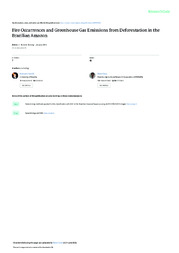Fire Occurrences and Greenhouse Gas Emissions from Deforestation in the Brazilian Amazon.
Fire Occurrences and Greenhouse Gas Emissions from Deforestation in the Brazilian Amazon.
Autoria: SILVA, C. A.; SANTILLI, G.; SANO, E. E.; LANEVE, G.
Resumo: Abstract: This work presents the dynamics of fire occurrences, greenhouse gas (GHG) emissions, forest clearing, and degradation in the Brazilian Amazon during the period 2006?2019, which includes the approval of the new Brazilian Forest Code in 2012. The study was carried out in the Brazilian Amazon, Pará State, and the municipality of Novo Progresso (Pará State). The analysis was based on deforestation and fire hotspot datasets issued by the Brazilian Institute for Space Research (INPE), which is produced based on optical and thermal sensors onboard different satellites. Deforestation data was also used to assess GHG emissions from the slash-and-burn practices. The work showed a good correlation between the occurrence of fires in the newly deforested area in the municipality of Novo Progresso and the slash-and-burn practices. The same trend was observed in the Pará State, suggesting a common practice along the deforestation arch. The study indicated positive coefficients of determination of 0.72 and 0.66 between deforestation and fire occurrences for the municipality of Novo Progresso and Pará State, respectively. The increased number of fire occurrences in the primary forest suggests possible ecosystem degradation. Deforestation reported for 2019 surpassed 10,000 km2, which is 48% higher than the previous ten years, with an average of 6760 km2. The steady increase of deforestation in the Brazilian Amazon after 2012 has been a worldwide concern because of the forest loss itself as well as the massive GHG emitted in the Brazilian Amazon. We estimated 295 million tons of net CO2, which is equivalent to 16.4% of the combined emissions of CO2 and CH4 emitted by Brazil in 2019. The correlation of deforestation and fire occurrences reported from satellite images confirmed the slash-and-burn practice and the secondary effect of deforestation, i.e., degradation of primary forest surrounding the deforested areas. Hotspots? location was deemed to be an important tool to verify forest degradation. The incidence of hotspots in forest area is from 5% to 20% of newly slashed-and-burned areas, which confirms the strong impact of deforestation on ecosystem degradation due to fire occurrences over the Brazilian Amazon.
Ano de publicação: 2021
Tipo de publicação: Artigo de periódico
Unidade: Embrapa Cerrados
Palavras-chave: Floresta Tropical Úmida, Forestry, Greenhouse gas emissions
Observações
1 - Por padrão são exibidas publicações dos últimos 20 anos. Para encontrar publicações mais antigas, configure o filtro ano de publicação, colocando o ano a partir do qual você deseja encontrar publicações. O filtro está na coluna da esquerda na busca acima.
2 - Para ler algumas publicações da Embrapa (apenas as que estão em formato ePub), é necessário ter, no celular ou computador, um desses softwares gratuitos. Sistemas Android: Google Play Livros; IOS: iBooks; Windows e Linux: software Calibre.
Acesse outras publicações
Acesse a Base de Dados da Pesquisa Agropecuária (BDPA) para consultar o acervo completo das bibliotecas da Embrapa.

